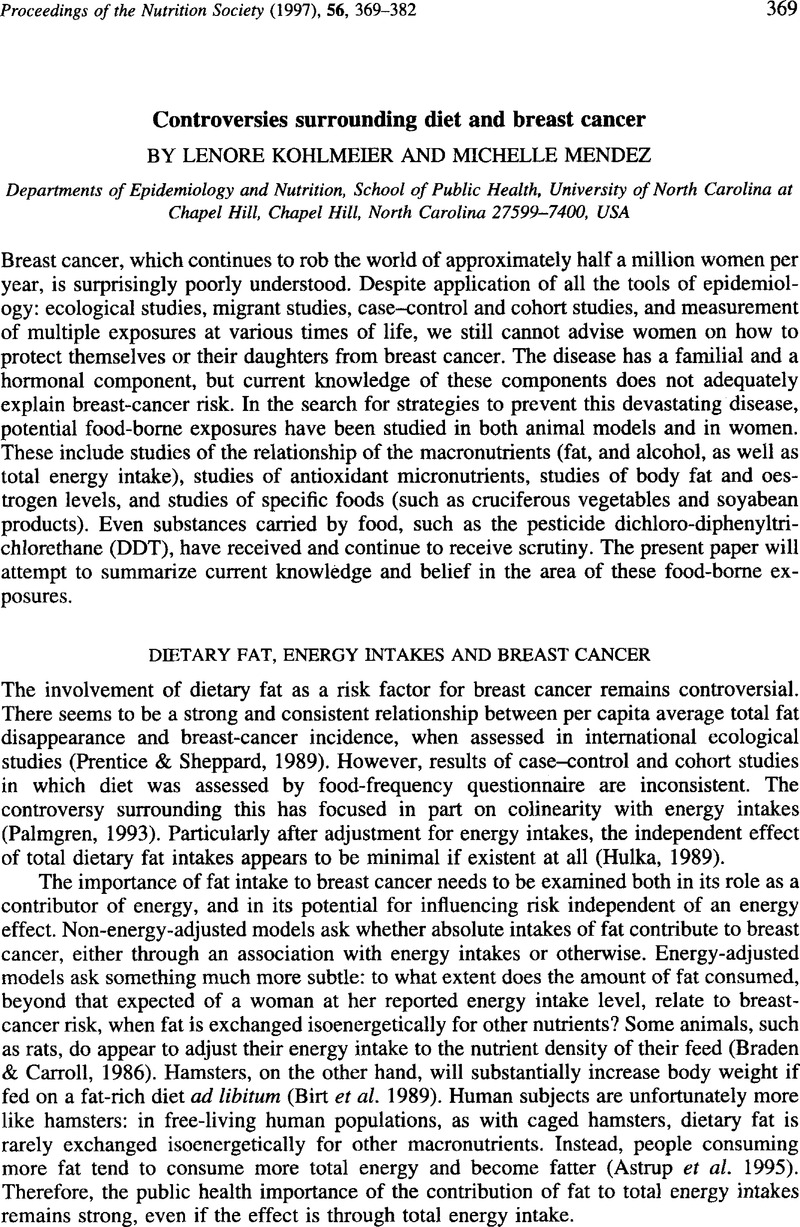Crossref Citations
This article has been cited by the following publications. This list is generated based on data provided by Crossref.
Pearlman, Deborah N.
Clark, Melissa A.
Rakowski, William
and
Ehrich, Beverly
1999.
Screening for Breast and Cervical Cancers: The Importance of Knowledge and Perceived Cancer Survivability.
Women & Health,
Vol. 28,
Issue. 4,
p.
93.
Männistö, Satu
Pietinen, Pirjo
Virtanen, Mikko
Kataja, Vesa
and
Uusitupa, Matti
1999.
Diet and the Risk of Breast Cancer in a Case-Control Study.
Journal of Clinical Epidemiology,
Vol. 52,
Issue. 5,
p.
429.
Cornell, Carol E.
Gilliland, M. Janice
and
Lewis, Cora E.
1999.
Handbook of Health Promotion and Disease Prevention.
p.
539.
Yang, Jihong
Nakagawa, Hiroyuki
Tsuta, Koji
and
Tsubura, Airo
2000.
Influence of perinatal genistein exposure on the development of MNU-induced mammary carcinoma in female Sprague–Dawley rats.
Cancer Letters,
Vol. 149,
Issue. 1-2,
p.
171.
2000.
Chemie in Lebensmitteln.
p.
287.
2001.
Cancer-related risk indicators and preventive screening behaviors among lesbians and bisexual women.
American Journal of Public Health,
Vol. 91,
Issue. 4,
p.
591.
Lima, Marilana Geimba de
Koifman, Sergio
Scapulatempo, Ilzia Lins
Peixoto, Maristela
Naomi, Silvia
and
Amaral, Maristela Curado do
2001.
Fatores de risco para câncer de mama em mulheres indígenas Teréna de área rural, Estado do Mato Grosso do Sul, Brasil.
Cadernos de Saúde Pública,
Vol. 17,
Issue. 6,
p.
1537.
Branca, F.
Hanley, A. B.
Pool-Zobel, B
and
Verhagen, H.
2001.
Biomarkers in disease and health.
British Journal of Nutrition,
Vol. 86,
Issue. S1,
p.
S55.
Castro, G.D.
Delgado de Layño, A.M.A.
Costantini, M.H.
and
Castro, J.A.
2001.
Cytosolic xanthine oxidoreductase mediated bioactivation of ethanol to acetaldehyde and free radicals in rat breast tissue. Its potential role in alcohol-promoted mammary cancer.
Toxicology,
Vol. 160,
Issue. 1-3,
p.
11.
Wahle, K.W.J.
and
Heys, S.D.
2002.
Cell signal mechanisms, conjugated linoleic acids (CLAs) and anti-tumorigenesis.
Prostaglandins, Leukotrienes and Essential Fatty Acids,
Vol. 67,
Issue. 2-3,
p.
183.
Majumder, B.
Wahle, K.W. J.
Moir, S.
Schofield, A.
Choe, Sun‐Nam
Farquharson, A.
Grant, I.
and
Heys, S. D.
2002.
Conjugated linoleic acids (CLAs) regulate the expression of key apoptotic genes in human breast cancer cells.
The FASEB Journal,
Vol. 16,
Issue. 11,
p.
1447.
Rehm, Jürgen
Room, Robin
Graham, Kathryn
Monteiro, Maristela
Gmel, Gerhard
and
Sempos, Christopher T.
2003.
The relationship of average volume of alcohol consumption and patterns of drinking to burden of disease: an overview.
Addiction,
Vol. 98,
Issue. 9,
p.
1209.
Hammond, Earl G.
Johnson, Lawrence A.
Su, Caiping
Wang, Tong
and
White, Pamela J.
2005.
Bailey's Industrial Oil and Fat Products.
Velie, Ellen M
Schairer, Catherine
Flood, Andrew
He, Jian-Ping
Khattree, Ravindra
and
Schatzkin, Arthur
2005.
Empirically derived dietary patterns and risk of postmenopausal breast cancer in a large prospective cohort study.
The American Journal of Clinical Nutrition,
Vol. 82,
Issue. 6,
p.
1308.
Asakage, Masahiro
Tsuno, Nelson H.
Kitayama, Joji
Tsuchiya, Takeshi
Yoneyama, Satomi
Yamada, Jun
Okaji, Yurai
Kaisaki, Shoichi
Osada, Takuya
Takahashi, Koki
and
Nagawa, Hirokazu
2006.
Sulforaphane induces inhibition of human umbilical vein endothelial cells proliferation by apoptosis.
Angiogenesis,
Vol. 9,
Issue. 2,
p.
83.
Nishikawa, Takeshi
Tsuno, Nelson H.
Tsuchiya, Takeshi
Yoneyama, Satomi
Yamada, Jun
Shuno, Yasutaka
Okaji, Yurai
Tanaka, Junichiro
Kitayama, Joji
Takahashi, Koki
and
Nagawa, Hirokazu
2009.
Sulforaphane Stimulates Activation of Proapoptotic Protein Bax Leading to Apoptosis of Endothelial Progenitor Cells.
Annals of Surgical Oncology,
Vol. 16,
Issue. 2,
p.
534.
Jun-Hee, Kim
Ki, Han Kwon
Jung, Ji-Youn
Han, Hye-Suk
Hyun Shim, Jung
Oh, SeJun
Choi, Kyeong-Hee
Choi, Eun-Sun
Shin, Ji-Ae
Leem, Dae-Ho
Soh, Yunjo
Cho, Nam-Pyo
and
Cho, Sung-Dae
2009.
Sulforaphane Increases Cyclin-Dependent Kinase Inhibitor, p21 Protein in Human Oral Carcinoma Cells and Nude Mouse Animal Model to Induce G2/M Cell Cycle Arrest.
Journal of Clinical Biochemistry and Nutrition,
Vol. 46,
Issue. 1,
p.
60.
Owiredu, W.K.B.A.
Donkor, S.
Wiafe Adda, B.
and
Amidu, N.
2009.
Serum Lipid Profile of Breast Cancer Patients.
Pakistan Journal of Biological Sciences,
Vol. 12,
Issue. 4,
p.
332.
Giskes, Katrina
Turrell, Gavin
Bentley, Rebecca
and
Kavanagh, Anne
2011.
Individual and household‐level socioeconomic position is associated with harmful alcohol consumption behaviours among adults.
Australian and New Zealand Journal of Public Health,
Vol. 35,
Issue. 3,
p.
270.
Singh Balhara, Yatan Pal
and
Mathur, Shachi
2012.
Alcohol.
Addictive Disorders & Their Treatment,
Vol. 11,
Issue. 2,
p.
101.



